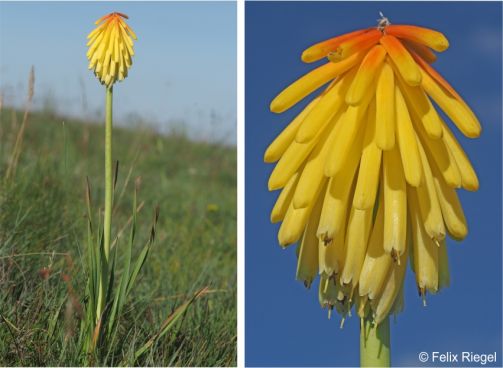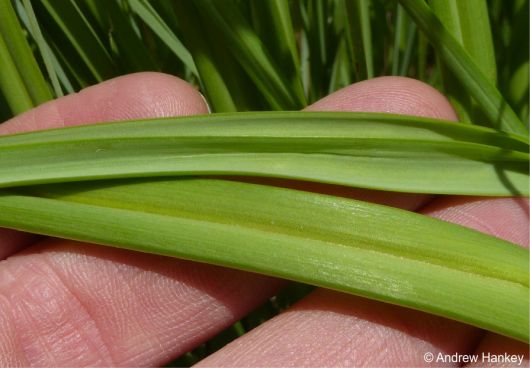Kniphofia porphyrantha
Kniphofia porphyrantha Baker
Family: Asphodelaceae
Common names: dwarf red-hot poker, highveld red-hot poker (Eng.), hoëveld vuurpyl (Afr.), icacane, umathunga (isiZulu), leloele (Sesotho)
Introduction
Kniphofia porphyrantha is a small, red-hot poker with numerous flowering stems, upright leaves becoming reflexed, and beautiful bi-coloured orange-red and yellow flowerheads in early summer. It is evergreen, fast-growing and hardy, well-suited for highveld gardens.

Description
Description
Kniphofia porphyrantha is a clump-forming, small, evergreen, fast-growing perennial with numerous stems that are 400–600 mm high. The leaves are yellow-green, 300-450 mm long and 6-14 mm wide, at first upright and later reflexed, with smooth margins and keel; the inner leaves are narrower and shorter than the outer ones. The flowerhead is globose to shortly cylindrical, 40-80 mm long and 50 mm broad. The flowers are tubular, 30-42 mm long; their colour varies from fiery red to orange with yellow to lemon-yellow tips. Flowering time is in late spring and early summer, from October to December, and can extend into midsummer, to January and February.

Conservation Status
Status
Least Concern (LC).
Distribution and habitat
Distribution description
Kniphofia porphyrantha is widespread inland between 1 300 and 2 300 m altitude, in moist areas, appearing in small clusters in grassy vleis and on damp grassy slopes in mountain grassland, in the Eastern Cape, Free State, Gauteng, KwaZulu-Natal, Mpumalanga and North West provinces of South Africa. It also occurs in Lesotho and Eswatini.

Derivation of name and historical aspects
History
The genus Kniphofia was named in honor of Johannes Hieronymus Kniphof, 1704-63, who was Professor of Medicine at Erfurt University, Germany. The species name porphyrantha means ‘purple flowers’, however the flowers are not purple and the reason for this name is unclear.
Kniphofia is a member of the Asphodelaceae family, which has over 750 species and 17 genera, 10 of which are found in South Africa. Africa is home to over 70 species of Kniphofia, 47 of which are located in South Africa’s eastern regions. The genus Kniphofia is very closely related to the genus Aloe. As a result, the first Kniphofia to be described, namely K. uvaria, was mistakenly thought to be an Aloe and was thus initially named Aloe uvaria.
Ecology
Ecology
Kniphofia porphyrantha is one of the three species of Kniphofia found in Gauteng. Flowers are attractive to sugarbirds and sunbirds, honeybees, butterflies, and other insects that pollinate the flowers while feeding on the nectar and pollen.
Uses
Use
Flowers are highly ornamental, and they bring a tropical flair and a beautiful, bright colour to the garden. Cut flowers can be put in a vase for decoration indoors. Plants in the Kniphofia genus are traditionally used to treat female infertility, malaria, hepatitis B and cancer, and as blood purifiers.

Growing Kniphofia porphyrantha
Grow
Divide the clump into smaller groups or single plants, cut the leaves short, leaving a few centimetres on the plant, and divide the roots using a garden fork. The division will occur easily; shorten the roots with a secateur. Plant the plants into the ground as soon as possible to prevent the roots from drying out, or cover them with damp material. Sow the seeds from spring to autumn; they will germinate after six weeks. Plant the seedlings into the ground when they are five to six months old. The plants will produce attractive flowers in two to three years. Kniphofia should not be divided or transplanted regularly because it takes a year to settle down and they will not flower well during this settling period.
Red-hot pokers are simple to grow. Place them in a sunny position with lots of water during the growing season to ensure that they flourish and flower well. They grow well in healthy compost-rich soil with mulch to retain moisture. Kniphofia porphyrantha is hardy.
References
- Codd, L.E. 2005. Fascicle 2: Asphodelaceae: Kniphofia. Flora of Southern Africa 5(1). SANBI, Pretoria.
- De Castro, A. & Victor, J.E. 2005. Kniphofia porphyrantha Baker. National Assessment: Red List of South African Plants version 2020.1. Accessed on 2024/01/22.
- Johannsmeier, M.F. 2016. Bee plants of southern Africa. Sources of nectar, pollen, honeydew and propolis for honey bees. Strelitzia 37. South African National Biodiversity Institute, Pretoria.
- Loughrey, J. 2022. How to grow red hot poker plants in your garden. Garden Design. Red Hot Poker (Kniphofia): A Growing Guide. Online. https://www.gardendesign.com/perennials/kniphofia.html. Accessed 23/01/2024.
- Nigussie, G., Tegegn, M., Abeje, D. & Melak, H. 2023. A comprehensive review of the ethnomedicine, phytochemistry, pharmacological activities of the genus Kniphofia. Pharmaceutical Biology 60(1):1177-1189.
- Phillips, E.P. 1992. Kniphofia porphyrantha Baker. The Flowering Plants of Africa 33: tt. 1291.
- Pooley, E. 2003. Mountain flowers, a field guide to the flora of the Drakensberg and Lesotho. Natal Flora Publications Trust, Durban.
- Stern, M. 2002. Kniphofia Moench (Asphodelaceae). PlantZAfrica. Online. http://pza.sanbi.org/kniphofia-species.
- Wentzel, J. n.d. Kniphofia porphyrantha. Wild Flower Nursery. Online.https://wildflowernursery.co.za/indigenous-plant-database/kniphofia-porphyrantha/. Accessed 22/01/2024.
Credits
Lesego Maunatlala
Pretoria National Botanical Garden
February 2024
Acknowledgements: the author thanks Felix Riegel, Andrew Hankey and Peter Warren for allowing the use of their images.
Plant Attributes:
Plant Type: Bulb
SA Distribution: Eastern Cape, Free State, Gauteng, KwaZulu-Natal, Mpumalanga, North West
Soil type: Sandy, Loam
Flowering season: Early Summer
PH: Acid, Neutral
Flower colour: Yellow, Orange
Aspect: Full Sun
Gardening skill: Average
Special Features:
Horticultural zones








Rate this article
Article well written and informative
Rate this plant
Is this an interesting plant?
Login to add your Comment
Back to topNot registered yet? Click here to register.